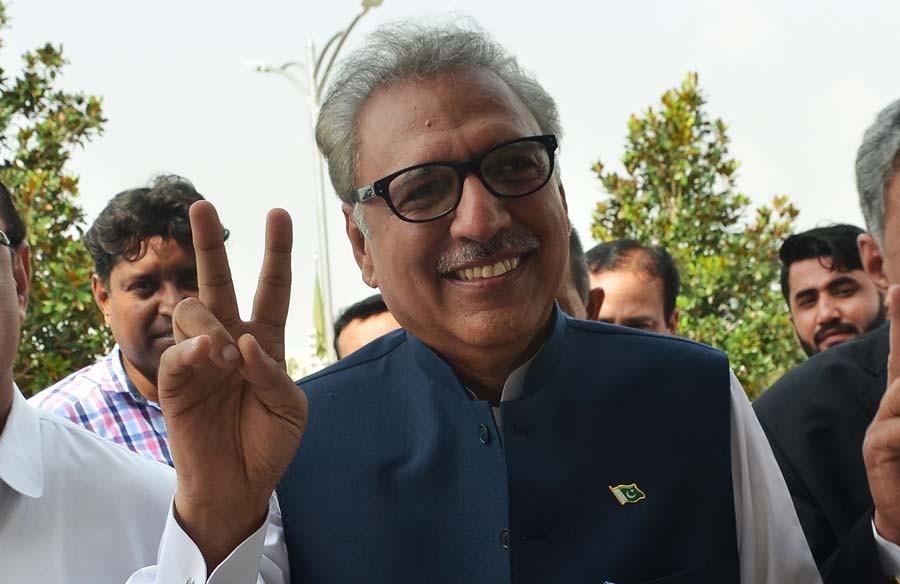
The cracks in opposition, reflected in the president’s election, are permanent and peculiar to the multi-party political system that Pakistan is evolving into

Given the current state of affairs of the opposition parties, particularly reflected in the presidential election, one wonders if they have the ability to form a joint strategy to hold the federal government accountable.
In fact, cracks started appearing in the hurriedly cobbled alliance against rigging soon after the speaker’s election. Even though the opposition parties who were part of the alliance had come to an understanding that they would have a joint candidate for the posts of speaker, prime minister and president, the PPP decided to abstain from prime minister’s election because it was unhappy over the candidature of Shahbaz Sharif. And when it came to the election of the president, it put forth as its candidate a man who is said to have annoyed the PML-N in recent months.
On the face of it, these rifts seem petty. Yet, amid a divided opposition, the ruling Pakistan Tehreek-i-Insaf (PTI) easily managed to get Dr Arif-ur-Rehman Alvi elected as the president of Pakistan on September 4, 2018.
According to the Election Commission of Pakistan (ECP), Dr Alvi got 352 electoral votes, while his two rivals, Maulana Fazal-ur-Rehman of joint opposition and Chaudhry Aitzaz Ahsan of Pakistan People’s Party (PPP) secured 184 and 124 votes respectively. As many as 1,110 members of the Electoral College (National Assembly, Senate and four provincial assemblies) cast their votes, with the election authority rejecting 28 votes. The president-elect will take oath after his predecessor Mamnoon Hussain completes his term today.
Glaring lack of consensus and trust among the opposition parties in fielding a joint presidential candidate enabled the ruling PTI to smooth sail to the presidential office. Likewise, a few weeks earlier in electing the prime minister, the opposition parties had stood divided -- the PPP ditched opposition candidate Shahbaz Sharif and decided to abstain from voting in the lower house. Sharif was left with no choice but to settle for the position of leader of the opposition in National Assembly.
Earlier, the PPP had declined to withdraw Ch. Ahsan as a presidential candidate, compelling the PML-N to bring Maulana Rehman into the race. Rehman who was supposed to moderate talks between the opposition parties to draw a consensus on a joint opposition candidate sprung a surprise when he himself was declared as the opposition’s presidential candidate.
"At the moment, the situation is embarrassing for the PML-N and its President Shahbaz Sharif. They are at the losing end," says senior journalist M. Ziauddin. "These divisions have dispelled the image of a united opposition."
As of now, he observes, "the PML-N seems under pressure. Sharif comes across as a weak opposition leader. The PML-N will remain weak in the opposition in National Assembly unless cases against Nawaz Sharif are decided and he is freed. Nawaz can create a significant impact on the PML-N in the parliament".
The PPP’s act of floating Ahsan as a presidential candidate much before the PML-N agreed on Maulana Fazalur Rehman was rather smart. But, to Ziauddin, the PPP strategy is vague, "whether it is under some pressure of the establishment or it thinks that in a combined opposition strategy, the PML-N will get all attention".
It appears now the opposition parties will come together only when in need of some constitutional amendment or to counter the ruling PTI on critical issues. "The approach of PTI will determine the opposition parties’ attitudes," Ziauddin adds.
Analysts think in terms of how the almost two party system gradually gave way to a three or multi party system, with not too dissimilar results. "We have to go back to the 1990s when the two major parties -- PPP and PML-N -- fought with each other and only the establishment benefited from it. But when the leaders of these parties went into exile, they managed to sign the Charter of Democracy and formed a coalition government in 2008," says political scientist Dr Muhammad Waseem.
Presently, he says, "these parties are opposing each other, and are giving an edge to the establishment’s choice - the ruling PTI". He further adds the PPP is indirectly helping the government "because it wants to have a good working relationship with the federal government when it has a government in Sindh."
Dr Waseem thinks the PML-N position in the parliament is weak, "despite winning the slot of opposition leader. The PML-N’s choice of Maulana as a presidential candidate was not good either."
Some think Shahbaz Sharif is not allowed to work independently and does not enjoy Nawaz Sharif and Maryam Nawaz’s trust. This grouping within the party is pushing the PML-N in a weak position.
"In the present situation, the opposition parties will continue their solo flights, safeguarding their vested interests," says Dr Waseem.
Serious political observers see no problem in political parties going their separate ways. In a multi-party system, with three major parties hogging the limelight, this is bound to happen. What they are concerned mostly is about the allegations of rigging and joint demand of a parliamentary commission to probe these allegations. The errant PPP claims it will stay united with the rest of the opposition in making this demand of the government. Its leader Qamar Zaman Kaira clearly says, "We only joined the opposition alliance against rigging".